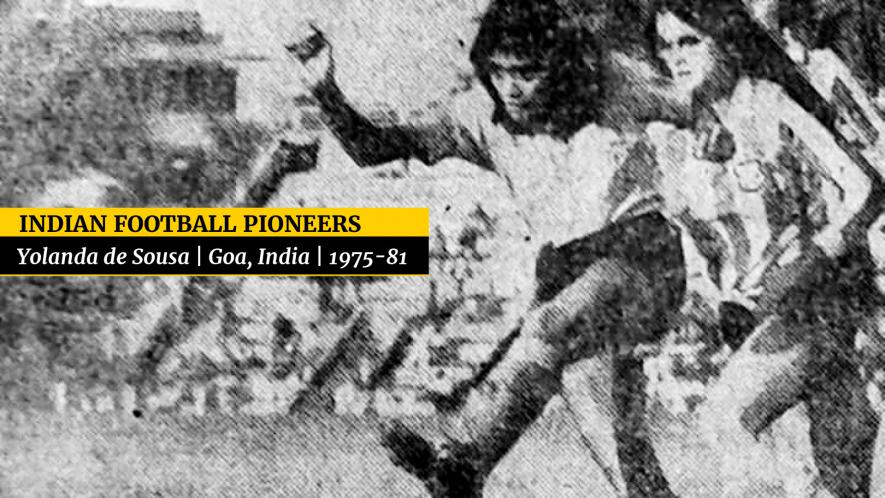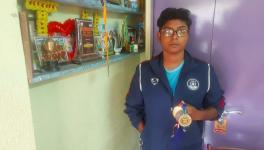Heart and Hat-tricks: Portrait of the Artist as a Young Footballer | Indian Women’s Football History Special Series

(Picture courtesy: Yolanda de Sousa)
Acrylic on canvas. Pink and purple. There is a texture in the application of the pain suggesting that painting isn’t just visual; touch is part of the experience. There is a genre called relief but this isn’t relief. Stylistically, the painting sits on the edge of both. It is the homepage of her website. A signature and an invitation.
The imagery is simple and stark. Two heads looking in opposite directions. Fragmented and abstract, strong colours, strong profiles. There is a sword between them. Splitting them. Dividing them. Looks like two people. Scorned lovers. A friendship broken. Strangers passing each other by.
The artist is a 67-year-old Goan who has exhibited across the world. Before you hear her talk it's important to look at this painting and contemplate a cliche: the synergy of art and sport. Sport can be art, but is art ever sport? Art is for art’s sake. This painting is the lowest common denominator, the thing that connects a national champion hat-trick scoring footballer, a thrillingly talented artist and a journalist trying to understand them both.
“That is a wrong notion that everybody has,” Yolanda de Sousa Kammermeier says, a snap response without much pause to a question about how she walked away from sport to become an artist. She’s quick to say that this thought comes from a mind restricted by the boundaries of modern education.
The young girl was born in Goa, the daughter of Rita Augusta de Sousa, a self-taught artist, who worked mainly on glass. Rita taught her daughter to draw, paint and see things differently. This was the 1950s. European art may have been booming but back home in Calangute, Goa, artists were mostly gifting, or making unpaid mementos. Art wasn’t as much a career to be pursued, as a luxury accommodated.
Also Read | Virat Kohli and the Stump Mic: Cape Town Incident Highlights Indian Cricket’s Disturbing Superhero Complex
Goa had other luxuries too, football for one, a sport that can’t actually be called religion because religion is organised, conditioned and restrictive. In Goa, football was as much a cultural necessity as fried fish and feni. The girl’s father was the famous Joveniano de Sousa, the pre-independence star of the Tata Sports Club in Bombay. She was obviously going to play the game.
She played with her elder brother. His friends. Boys who put her in goal. She was too young to be much use anywhere else. She played at the grounds sprinkled around the village, on the beach even and then came home and painted the day’s play.
By the time Yolanda found these two creative pursuits in conflict with each other, it was the final year of school.
“I was an artist even when I was playing football,” she says. This isn’t some idealistic monologue about the sporting spirit. It has a point. “It wasn’t one or the other. Both existed simultaneously. There was strife but also harmony.”
“When you’re young, you play sports. And at the same time, you become the artist of the school. The arty work is given to you. I was doing both those things.”
With the final year of school came the need to pick a discipline that would open up a career option. Subjects you chose would define which college you went to, what you went on to be in your life. Students picked seven subjects and an extra one to aid you in case you flunked your first list. Yolanda decided she wanted to become an artist and she picked art in her final year of school, knowing fully well that there was no teacher at the institute.
“Most kids would take typing,” she says. “They thought it would help them professionally. Help them land jobs. I was the only one who took art. For me, that was my career. Playing was for fun.”
Yolanda got through to the newly minted Goa College of Art. Most of her state teammates went to St. Xavier’s. Xavier’s had no art faculty, and GCA no sport. The obvious choice became tough to follow. Peer pressure — and a sibling who would not relent — forced her to reconsider her choices.
“My sister nicely brainwashed me,” she laughs. “She’d say ‘What are you doing there? You can’t play forever… so play now. You can do your art and all in two years’. I almost fell for it. Even went as far as the GCA Principal’s office to tell him I’d prefer to be transferred.”
It’s crazy to think that almost half a century later, the conundrum that almost killed Yolanda’s duality still exists. Variant interests, minimal infrastructure, regimented education and confused teenagers are forced into shutting down their sporting dreams early even today.
Also Read | Reality Check or Bad Luck? The Curious Case of Sandesh Jhingan’s Short Croatian Sojourn
Thankfully, St. Xavier's principal Father Nicolas sat her down and told her there was no way she should consider the transfer and told her sister to knock it off. Her principal at GCA agreed to let her go for any camps she needed to, and assured her the lost attendance would not factor in.
Yolanda had played badminton for her state by now. She had also been part of the state hockey team, having been introduced to the sport by Goans migrating back to the state from Africa. Sport was fun, part recreation, part competition. She was a valued sports person in the community, but football hadn’t factored in yet. The beautiful game was played to pass time.
This again was a forced choice.
In the early 1970s, the Indian football association did not accommodate women. FIFA didn’t recognise the women’s game either. Women playing football were renegades. And these renegades sprouted a counter cultural revolution which spread across the world. Women’s football federations independently sprouted up, and rallied under similarly independent continental banners. They took charge of the game.
In 1975, India fielded a women’s side and invited Thailand for a friendly. The match would be held under the purview of the newly formed Women’s Football Federation of India (WFFI). Inasmuch as the WFFI was revolutionary, it was also part of a theme going around. The Thailand game would be India’s first ever international women’s football fixture. The team lost.
Yolanda saw the game. It was something new and she felt differently about it. “At that time I’d heard that there were two villages in Goa where girls had teams and played football,” she says. “I decided that it was time my village Calangute did so too. I rallied up some girls — as a village we were very good at sports — and we hit the beach and started playing.”
She remembers a bunch of village boys watching them play and inviting them to come play at the ground. They would play with the boys. And this time she wasn’t playing in goal. A year later, the Goan team, with Yolanda in it, reached the final of the 1976 Nationals in UP. Bengal won the title, but Yolanda, the headlines. She had basically scored in hat-tricks the entire tournament.
Also Read | Women’s Sport In India Remains Positive About Its Future
This innocent headiness, a carefree amateur energy are recurrent themes in her memories. It was a different India, but also much the same. This was 1976 when a woman was the most powerful person in the land.
Yolanda ended up the highest scorer at the Nationals (courtesy of a sea of hat tricks that eventually became her USP) and so obviously was in the National camp put together to play Tippornas BK, a Swedish club side touring India later that year. On her debut, Yolanda scored (what else but) a hat trick, the first Indian to do so in an international fixture and helped India seal their first victory over a visiting side.
“The first game of that tour was in Sultanpur. It had been the venue of the 1976 Nationals, my first nationals, a superb hunting ground for me,” Yolanda recalls. “The crowds were great. The stadium was the open sort, with one small enclosed structure but otherwise just a standing arena. There would be over 10,000 people turning up for the matches. Against the Swedish team also the ground was packed.”
It was a time when Indians watched football played by Indians on Indian grounds. The team’s brilliance helped. The Nationals were a huge success and the national team it birthed even more so. India reached the final of the 1980 AFC Asian Women’s Championships in Calicut (now Kozhikode). The performance, their best at the Asian level ever, was buoyed by a generation of talent whose stories are never forgotten but have at the same time become a little blurry. Shanti Mullick, Shukla Dutta, Yolanda de Sousa, Chitra Gangadharan… the names are history. And historical. They should carry with them the romance associated with an earlier time. But modern sport has no time for sepia filters.
Also Read | Right To Play: The Unsuspecting Casualty of a Pandemic
“Let me tell you something else,” Yolanda says, in a tone that suggests criticism arriving, “In those days there was a huge amount of media coverage as well. Whatever the reasons, that stopped and has only recently been revived.”
The reasons are complex. Those initial years of women’s football were organised between nations and confederations, with no global body to supervise proceedings. As a result, there were several ‘World Cups’, held, contested and forgotten by all but those who played them. The Indian women’s team contested in one in 1981, in Taiwan, records for which are not easily available. Yolanda remembers India holding out the eventual champions from Germany to a draw in the opening encounter. They underperformed, by her reckoning, handicapped by an inexperienced coach and a team that lost all discipline on foreign shores (‘We were shopping, roaming around, being tourists, everyday’).
The first women’s tournament recognised by FIFA was played in 1988 in China — an invitational ‘World Cup’ with 12 teams. The nations participating in it had merged their women’s associations with the national federation. Three years after that event, India followed suit. The WFFI folded up and merged with the All India Football Federation (AIFF). Indifference followed. Media apathy was an obvious next.
“In my opinion that initial boom in women’s football was never captured and capitalised on. When that merger happened, a huge amount was lost,” Yolanda says. “The men were given charge of the game. And these guys were just not interested in women’s football. Any success we had, any headstart we made, just crashed. They had to start from scratch.”
But starting from scratch requires a desire to start at all. In the 1990s and the early 2000s, Indian women’s football remained on the margins of the nation’s imagination. Clubs put out teams, but there was no consolidated push towards offering them opportunity, competition or even playing time. The legacy of that 1970s swashbuckling team was gently undone by a few decades of apathy.
In 2009, almost two decades after the AIFF took control of women’s football in the country, India was struck off the international rankings for having not played a fixture in 18 months. As late as 2018, the national women’s team was struggling to play fixtures spaced out over 12 months. The Indian Women’s League (IWL), a fairly recent addition to the domestic football calendar, took 26 years in the making. And yet, a new opportunity has emerged, as India prepares to host the AFC Women’s Asian Cup later this month. The national team has made the headlines from their recent sojourn in Brazil, and there is a lot of hope and expectation riding on this moment — a resurgence for the game for girls in the country.
Much before all this happened, Yolanda retired from the game — forced out by knee injuries — and gracefully walked away into an artistic sunset. Several members of that generation — Chitra and Shukla Dutta most famously — have remained attached, managing different roles in the game in the country.
Not India’s famous hat-trick hero though. She’d kept up at art school while she played for India. And at the first opportunity she walked right back.
“I’d decided right at the start that when I stopped playing football I’d just walk away from the sport,” she says. “It’ll just be my art. It was simple. You cannot serve two masters.”
Also Read | Memories of a Sporting Year Unforetold
This is a contradiction, from where we began. A neat circle back to the beginning. This can go on for eternity. Art, Football and the impossibility of doing it all.
But again, there are neat synchronicities between the two. Football is a team sport. Art, an individual pursuit. “But football requires individual thought too,” Yolanda exclaims. “Your mind needs to work individually to help the collective. The move has to be an individual thought that works the game for the team.”
Art too is a social endeavour. Artists may be reclusive but their interactions with society form the basis of their work. If art is a commentary on society then sport is its adhesive.
In India, both endeavours remain difficult to pursue, much less professionally. Despite the proliferation of art galleries, artists remain marginalised, under appreciated and very restricted in India. Artist struggle has been an integral part of art, but in modern society, the struggle isn’t for representation as much as it is recognition.
Women’s football in India remains largely an amateur sport, with few opportunities to play professionally and through the year. The IWL, launched in 2017, is a step forward. A bare minimum requirement that is still being worked out. But at the grassroots there is a wide call for change. Women want to play and refuse to accept norms that keep them away from the field in any way. Some states, very specifically, lead the way. It’s only a start.
“You know what the thing is,” Yolanda says, “I didn’t ever want to do something someone else wanted me to. Painting is something that makes me happy. I can express myself without restraint. And it is also something that extends that opportunity to the viewer. They can see what they want to.”
The painting on her homepage is titled Entra a Spada e a Parede. Caught between the sword and the wall. It is in hues of pink. Acrylic on canvas. Two faces looking in two directions. But, like a well constructed Venn diagram, they share one brain.
Get the latest reports & analysis with people's perspective on Protests, movements & deep analytical videos, discussions of the current affairs in your Telegram app. Subscribe to NewsClick's Telegram channel & get Real-Time updates on stories, as they get published on our website.
























